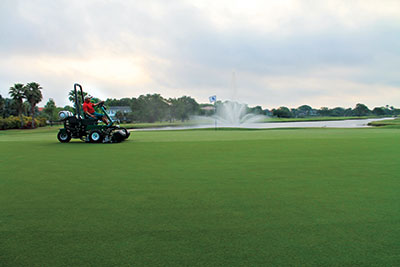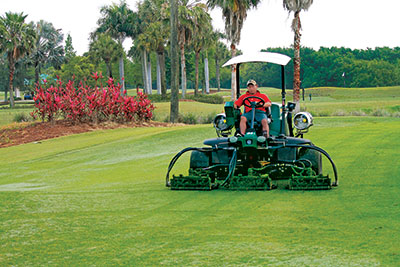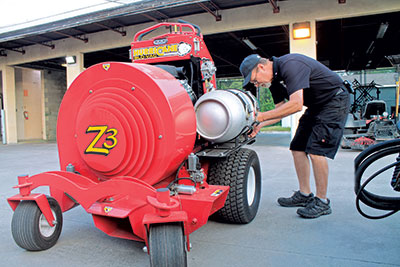Propane (provides saving) power
 Propane has a new home at the Vinoy Resort & Golf Club in Florida thanks to results seen at the course during an elective program.
Propane has a new home at the Vinoy Resort & Golf Club in Florida thanks to results seen at the course during an elective program.
“The best thing we have seen is there has been no change in the quality of mowing or anything.”
That’s Scott Corwin, director of grounds at the Vinoy Renaissance St. Petersburg (Fla.) Resort & Golf Club, speaking about the performance of propane equipment on his course.
Corwin’s Vinoy, a Marriott Golf property, was one of eight courses enrolled in a program led by the Propane Education & Research Council (PERC) and Audubon International. The program was the subject of a Golfdom article in the August 2015 issue. Each participating course was loaned propane-powered technologies for at least a year. In return, the courses agreed to record performance data.
Marriott Golf learned about the opportunity in late 2014 through its connection with Audubon International. The company enrolled the Vinoy, Stone Mountain (Ga.) Golf Club and Desert Springs Resort, Palm Desert, Calif., in an attempt to study propane’s effect on a property’s carbon footprint and fuel-cost savings.
“We’re constantly looking at new ways we can improve our golf course operations,” says David Robinson, CGCS, senior director of golf grounds, Marriott Golf. “We look at our carbon footprint at all of our properties. We’ve done the calculations, so this was a great next step to enable us to reduce our carbon footprint even more.”
“When we got approached a year and a half ago,” Corwin adds, “I talked to Eric (Kulaas, equipment tech supervisor at the Vinoy), and of course the first thing in my mind was we were getting free equipment for a year.”
R&R Products Director of Propane Applications Jim Coker dropped off a mini-fleet of equipment on Feb. 17, 2015, including a Reel Max 544 LP fairway mower, a Reel Max 331LP finish-cut reel mower, a Greens Max 2200LP riding greens mower and a Sand Max 521LP bunker rake.
More than a year later, Robinson says that the results on the three Marriott Golf properties varied (see “Stone Mountain pulling the plug,”), but overall were “great,” and the equipment received positive feedback. But Corwin’s and Kulaas’ experience stood out from the rest.

“There were no nerves about the equipment. The crew just looked at it as a piece of equipment and (said) ‘I’ll go do my job,’” says Corwin. “Our propane triplex mower gets used more than anything. I don’t know if it’s because it’s new or more comfortable.”
The pair has embraced the new equipment with such enthusiasm that they have purchased the loaned equipment from R&R Products, as well as a propane-powered blower, and are looking to convert more of their equipment from diesel to propane.
“The Vinoy really embraced it to another level,” Robinson says. “We were hoping that would be the case at one of the properties so we could study even more.”
The once and future cost
“There’s this misconception when you look at other alternative fuels that there are other hidden costs in converting the new fuel,” says Jeremy Wishart, PERC’s deputy director of business development. “It just so happens with propane (that) the cost of the equipment is less, the cost of the fuel right now as the national average is 30 percent less (than) cost of gas and diesel.”
Over the year that the propane equipment was on loan to the Vinoy, Corwin saw significant savings on fuel. The course spent 25 percent less on the fuel for the Sand Max 521LP and Greens Max 2200LP, and 45 percent less for the Reel Max 544 LP and Reel Max 331LP.
After a steady decline for two years, the national average for diesel reached $1.99 per gallon last February, the lowest price seen since January 2005, according to EIA.gov. Corwin remembers March 2012, when the average was at the highest this century, and he and thinks the price will be trending up again sooner rather than later.
“At one point we were paying $4 per gallon,” Corwin says. “So when gasoline increases — which it will again, it won’t stay this low forever — then that’s when we will see true savings again.”
Another feature that differentiates propane from diesel and gasoline is the ability to negotiate with a propane dealer and lock in a price even lower than the national average, something that Corwin only learned about during a recent visit from Coker.
“It effects your budget when those prices fluctuate, but if you purchase a certain amount you can set a price for the entire year,” Coker says. “It works because the propane retailer can pre-buy the propane knowing how much you use, and lock in a price.”
Corwin is a superintendent geared toward the future and helping his course succeed, but Tier 4 engines and their upcoming incarnations have him worried.
“One thing that people are missing the boat on is that technology is a good thing, but it can be bad,” he says. “There’s Tier 4 right now, but next thing you know it’ll be Tier 5. It gets bigger and better, but what’s that going to do for your equipment maintenance budget?”
Despite Marriott Golf being able to purchase equipment at “good” pricing, Robinson confirms they are seeing a 15-percent to 20-percent increase in the cost of equipment because of Tier 4.
“That’s a big number when you already start high,” Corwin adds. “Basically you are at 15 to 20 percent added on to a $40,000 piece of equipment. I just have to shake my head at the price.”

Eric Kulaas, the Vinoy’s equipment tech supervisor, changes a fuel tank on the clubs’ stand-on blower, which has been converted to use propane.
Corwin sees only more bills piling up by investing in Tier 4 technology. He notes that if a mower breaks down, his mechanics aren’t going to be able to work on them without computers, and it will have to be sent to the manufacturer for repairs. According to Kulaas, that currently costs $100 an hour, and he expects the price to increase with Tier 4 and beyond.
More than money
As AC/DC sings, “Come on, come on, listen to the money talk,” but Corwin and Robinson agree that enlisting in the program also was about reducing emissions and improving employee and member safety.
“Yes, the savings and dollar amounts are great, but when we approach these different environmental programs and initiatives, that’s not the first thing we look at,” Robinson says. “The first thing is the impact to the environment and associates, employees, members and guests, and ultimately what it does long term in a positive way for the golf course.”
Though this program is an attempt to gauge propane emissions at the eight golf courses, PERC says that in general, propane reduces greenhouse gas (GHG) emissions and carbon monoxide (CO) emissions by 15 percent and 40 percent, respectively, compared with gasoline and diesel. They also report that propane is 64 percent better in GHG emissions and 50 percent better in CO emissions than current Environmental Protection Agency minimum regulations.
“Eric and I, we are getting to the end of our careers, and I was looking at PERC’s program and thought it would be a good way to finish out and do the right thing for the community by looking into an alternative fuel,” Corwin says. “This just enhances the Vinoy. There’s thousands of Vinoys out there, and this just sets us apart and it gets our name out there.
“It sounds boring, but there hasn’t been any difference,” he continues. “It’s just a different habit to fill the machine with (propane). That’s it.
Photos: Grant b Gannon









